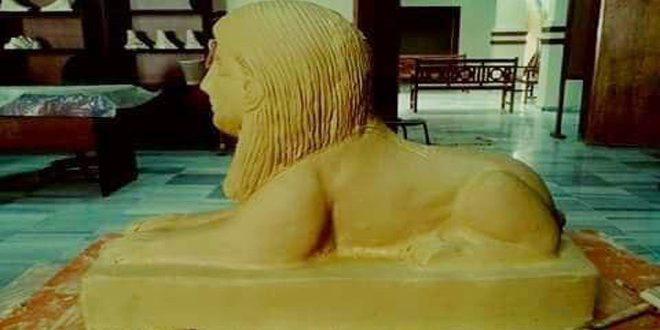The young plastic artist Nagham Mansour tended to carve model sculptures and antique inscriptions that were inspired by the civilizations of our ancestors reflecting in a contemporary way the exquisite and accurate drawings they left, which allowed her to achieve a distinguished place in the world of the plastic art within a short period.
Regarding her experience in the field of sculpture, Mansour explained in an interview with SANA that she chose this art because it simulates and embodies reality .The support and encouragement of her family and friends after the two exhibitions that she held in Homs, had the most important role in her artistic career she adds.
Mansour participated in an exhibition at the “Masar Festival” with more than 500 artworks for her and her students, including various handicrafts, paintings in charcoal, ceramics, flower making, drawing on glass and engraving on wood.
 She continued her studies at the Fine Arts Center at the Ministry of Culture, specializing in sculpture and graphics, as she held her first solo exhibition displaying sculptures on the antiquities of the ancient Kingdom of Qatana in her village Al-Meshrfeh.
She continued her studies at the Fine Arts Center at the Ministry of Culture, specializing in sculpture and graphics, as she held her first solo exhibition displaying sculptures on the antiquities of the ancient Kingdom of Qatana in her village Al-Meshrfeh.
Mansour, who is keen on experiment and constant research, adopts clay for her artistic works. “I like to use this material a lot, since it is from nature and connects us to the soil of the homeland, which is our most valuable possession. However, I also used gypsum, polyester, fiber, silicon, glass, wood, collages, environmentally damaged materials, cloth, velvet, beads, ceramics and wool. As for the work of drawing, I use all the watercolor, acrylic, pastel, oil, charcoal pens, pencils, and walnut ink on canvas and Canson papers in different sizes,” She clarified.
“My passion for engraving archaeological sculptures and wall drawings stemmed from my love for the soil of the homeland, which was watered with the blood of our martyrs. The clay was my first inspiration for carving antiquities and ancient wall drawings, as well as the encouragement and support that I got from different sides in Homs helped me to continue,” she added.

Concerning the topics that she chooses in her work, Mansour explained that her being a teacher of art education in the institutes and schools of Homs has contributed to refining and improving her ideas and visions in several directions that intersected with human being in a variety of expressive, classic, emotional, historical and archaeological methods.
Mansour showed that her main goal and real desire is to pay attention to children’s creativity and change students’ perception of art education so that it becomes a space for psychological comfort, creativity and innovation, awakening and encouraging talents, and developing awareness and aesthetic taste of art, which leaves positive effects and impressions in the future.
Talking about the presence of women in her works, she mentioned that the female figure in art is the first inspiration for creativity, and so she embodies her in many of her works, including an oil painting from mythology entitled “Cupid of Love and His Wife, Psyche”. She also embodied her with archeology in more than one sculptural work that shows women and their role in civilizations.
It is noteworthy that Nagham Mansour was born in Homs. Several international bodies honored Mansour for her participation in the exhibition “My paint brush is Love and Peace among the Peoples”. She also participated in carving works and festivals in a number of Arab and foreign countries.
Amal Farhat

